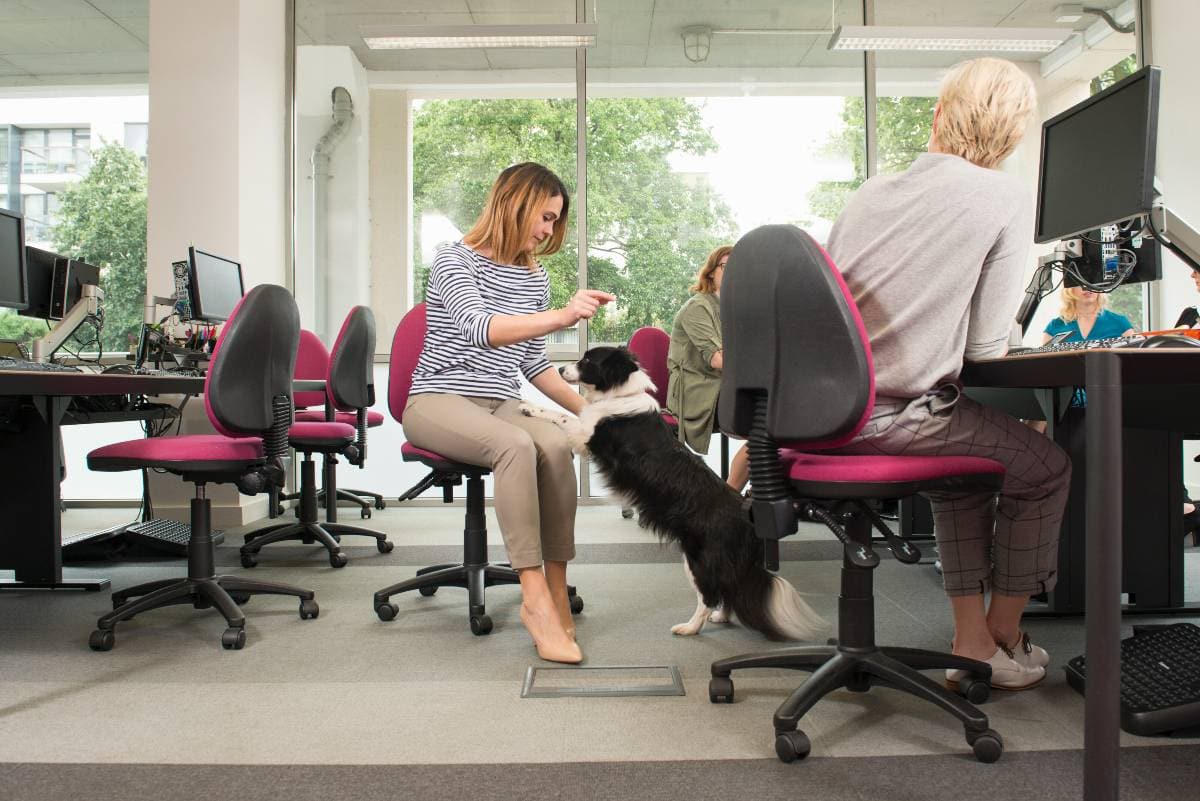As we navigate the ever-evolving landscape of tenant preferences and workplace dynamics, one trend stands out: the rise of pet-friendly office spaces. With over 18 years in the industry, I’ve witnessed firsthand the transformative power of adapting to market demands. In this comprehensive guide, we’ll explore how embracing pet-friendly policies can revolutionize your property’s appeal, boost tenant satisfaction, and ultimately, enhance your bottom line. Let’s embark on this journey to unlock the untapped potential of your commercial real estate investments.
Key Takeaways
- Pet-friendly commercial properties are becoming increasingly popular, offering a competitive edge in tenant attraction and retention.
- Implementing pet-friendly modifications requires careful consideration of legal, financial, and practical aspects.
- Successful pet-friendly spaces balance the needs of pet owners and non-pet owners while enhancing overall workplace satisfaction.
Understanding the Pet-Friendly Property Trend
Let’s face it, folks: the demand for pet-friendly spaces is through the roof. It’s like everyone suddenly realized that Fido makes for a great coworker!
Current market demand
Picture this: You’re a tenant looking for new digs. You come across two identical office spaces, but one allows pets. Which one are you more likely to choose? If you’re like most people these days, you’re probably already imagining your furry friend curled up under your desk.
According to a survey by the American Pet Products Association, 67% of U.S. people own a pet. That’s a lot of potential tenants looking for pet-friendly workplaces!
Impact on tenant attraction and retention
Here’s the kicker: pet-friendly policies aren’t just about attracting new tenants. They’re a secret weapon for keeping those tenants around. It’s simple math, really. Happy employees = happy tenants = long-term leases. And what makes employees happier than having their four-legged friends by their side?
Studies have shown that pet-friendly workplaces can:
- Reduce stress levels by up to 11%
- Increase job satisfaction by 22%
- Boost employee morale and productivity
Competitive advantage in commercial real estate
In the cut-throat world of commercial real estate, standing out is key. And let me tell you, nothing makes a property stand out quite like being pet-friendly. It’s like having a built-in marketing tool that practically sells itself!
Consider this: According to The Humane Society, 72% of renters reported that pet-friendly housing is important to them. While this survey focused on residential properties, the sentiment often carries over to commercial spaces, especially as the lines between work and home continue to blur.
Legal Considerations and Compliance
Now, before you start rolling out the red carpet for every Rover and Whiskers out there, let’s talk legalities. Because trust me, you don’t want to be caught with your tail between your legs when it comes to compliance.
ADA requirements and service animals
First things first: service animals are in a league of their own. The Americans with Disabilities Act (ADA) has specific requirements for these working animals. And no, your tenant’s emotional support peacock probably doesn’t count.
Key points to remember:
- Service animals are not pets; they’re working animals
- Only dogs and miniature horses are recognized as service animals under the ADA
- You cannot ask about a person’s disability, but you can ask if the animal is required because of a disability and what tasks it has been trained to perform
Local health codes and zoning regulations
Every city has its own quirks when it comes to zoning rules and health codes. Some might welcome pets with open arms, while others might have more restrictions than a cat has lives. Do your homework, folks!
For example:
- Some cities require special permits for businesses allowing pets
- Health codes may restrict pets in areas where food is prepared or served
- Zoning laws might limit the number of animals allowed in a commercial space
Insurance implications and liability concerns
Let’s talk about the elephant in the room (or should I say, the Great Dane?): liability. Your insurance company might have a bone to pick with you if you don’t disclose your pet-friendly status. And don’t even get me started on the potential for property damage. It’s all manageable, but you’ve got to have your ducks (or dogs) in a row.
Consider:
- Updating your general liability insurance to cover pet-related incidents
- Requiring tenants to have renter’s insurance that covers pet liability
- Implementing a pet deposit or additional pet rent to cover potential damages
Essential Pet-Friendly Modifications
Alright, time to get our hands dirty with some property upgrades. Because if you’re going to do this pet-friendly thing, you might as well do it right!
Outdoor spaces and relief areas
- Dog runs and exercise zones: Think of it as a playground for pups. A little space where they can stretch their legs and do their business. Consider:
- Artificial turf for easy maintenance
- Agility equipment for extra exercise
- Shaded areas for hot days
- Waste disposal stations: Trust me, you don’t want to skimp on these. Your human tenants will thank you. Include:
- Biodegradable waste bags
- Covered trash cans
- Hand sanitizer dispensers
Interior adaptations
- Flooring: The carpet might be cozy, but it’s not exactly Fido-friendly. Think durable materials that can stand up to paws and claws. Options include:
- Luxury vinyl tile (LVT)
- Polished concrete
- Commercial-grade hardwood
- Pet-friendly elevators and common areas: Wide corridors, non-slip surfaces, and maybe even a designated “pet wash” station. Get creative! Consider:
- Paw-print floor decals leading to pet areas
- Water fountains with ground-level bowls for pets
- Dedicated pet relief rooms for bad weather days
Safety features and access control
Remember, not everyone’s a pet person. Consider implementing controlled access areas or pet-free zones for those who prefer their workspace without a side of fur. Ideas include:
- Keycard access to pet-friendly areas
- Clear signage indicating pet-free zones
- Baby gates or half-doors to restrict pet access
Tech integration for pet management
Welcome to the 21st century, where even Rover has his own app!
- Pet tracking systems: Lost pets? Not on your property! Implement:
- RFID collar tags for building access
- GPS tracking for communal areas
- Digital pet profiles accessible to property management
- Automated check-in/out processes: Who doesn’t love a good tech solution? Consider:
- QR code scanners for quick pet check-ins
- Automated notification systems for pet policy reminders
- Digital health certificate storage

Implementing Pet Policies and Procedures
Now, let’s talk rules. Because as much as we all love pets, we can’t have the office turning into a zoo (unless that’s your business model, in which case, carry on!).
Developing comprehensive pet policies
Think of this as your pet constitution. It should cover everything from behavior expectations to cleanup responsibilities. And make sure it’s crystal clear – no room for “the dog ate my policy” excuses!
Key elements to include:
- Pet registration process
- Leash requirements in common areas
- Noise control expectations
- Cleanup and damage responsibilities
- Consequences for policy violations
Registration and vaccination requirements
Keep those vaccination records up to date, folks. Nobody wants to deal with a canine flu outbreak in the middle of tax season.
Consider requiring:
- Annual proof of vaccinations
- Regular flea and tick treatments
- Health certificates from a licensed veterinarian
Size, weight, and breed restrictions
Now, I’m not one to discriminate, but sometimes size does matter. Especially when it comes to shared office spaces. Consider what’s reasonable for your property.
Factors to consider:
- Building layout and elevator capacity
- Potential impact on other tenants
- Local regulations on specific breeds
Behavior standards and training requirements
A well-behaved pet is a joy to have around. A poorly behaved one? Well, let’s just say it can lead to some interesting water cooler conversations. Set clear expectations from the get-go.
Potential requirements:
- Basic obedience training certification
- Temperament assessments for new pets
- Probationary periods for pets new to the office environment
Managing Potential Challenges
Alright, time for some real talk. As amazing as pet-friendly offices can be, they’re not without their challenges. But don’t worry, I’ve got your back!
Addressing allergies and pet phobias
Not everyone’s a fan of fur. Consider designating pet-free zones or implementing air purification systems. It’s all about finding that balance.
Strategies to consider:
- HEPA air filters in common areas
- Regular deep cleaning of carpets and upholstery
- Offering alternative work areas for those with severe allergies
Noise and odor control strategies
Let’s face it: pets can be noisy and, well, smelly. Invest in good soundproofing and ventilation. Your non-pet-owning tenants will thank you.
Consider implementing:
- Sound-absorbing materials in pet-friendly areas
- Odor-neutralizing sprays and air fresheners
- Regular professional cleaning services
Conflict resolution between tenants
Where there are pets, there can be pet-related disputes. Have a clear process in place for addressing concerns. And maybe keep some dog treats on hand – they’re great peace offerings!
Steps for effective conflict resolution:
- Establish a clear complaint procedure
- Mediate disputes impartially
- Document all incidents and resolutions
- Be prepared to enforce policies consistently
Financial Considerations
Now, let’s talk money. Because at the end of the day, we’re all in this to make a profit, right?
Costs of pet-friendly modifications
Sure, there might be some upfront costs. But think of it as an investment in your property’s future. Plus, have you seen what people are willing to pay for dog daycare these days?
Potential costs to consider:
- Flooring upgrades
- Outdoor area modifications
- Pet amenities (wash stations, relief areas, etc.)
- Additional cleaning and maintenance
Pet deposits and additional fees
It’s okay to charge a little extra for those furry tenants. Just make sure it’s reasonable and clearly outlined in the lease.
Options to consider:
- One-time pet deposit
- Monthly pet rent
- Additional cleaning fees
Potential impact on property value and rental income
Here’s the good news: pet-friendly properties often command higher rents and have lower vacancy rates.
According to a study by FIREPAW, Inc.:
- Pet-friendly properties had 91% lower vacancy rates
- Pet-friendly units could charge 10-15% more in rent
- Pet owners stayed an average of 23 months compared to 15 months for non-pet owners
Marketing Your Pet-Friendly Property
Time to show off all your hard work! Let’s get the word out about your paw-some property.
Highlighting pet amenities in property listings
Don’t be shy about those dog runs and pet wash stations. These are selling points, folks!
Key features to highlight:
- Pet relief areas and exercise zones
- Pet-friendly common areas
- On-site pet amenities (grooming stations, daycare services, etc.)
- Pet-specific events or socials
Targeting pet-owning demographics
Know your audience. Millennials and Gen Z? They’re all about that pet life. Market accordingly.
Strategies to consider:
- Partner with local pet businesses for cross-promotion
- Advertise in pet-focused publications or websites
Leveraging social media and local pet communities
Instagram-worthy pet spaces? Check. Partnerships with local pet businesses? Double-check. The possibilities are endless!
Ideas to try:
- Create a property-specific pet Instagram account
- Host pet photo contests for tenants
- Sponsor local pet events or charities

Maintaining a Pet-Friendly Environment
The work doesn’t stop once you’ve gone pet-friendly. Maintenance is key to keeping everyone happy – two-legged and four-legged alike.
Regular cleaning and maintenance protocols
Invest in a good cleaning crew. And maybe stock up on lint rollers while you’re at it.
Key areas to focus on:
- Daily cleaning of pet relief areas
- Regular deep cleaning of carpets and upholstery
- Frequent air filter changes
Staff training and tenant education programs
Everyone needs to be on the same page when it comes to pet policies. Regular training sessions can help keep things running smoothly.
Topics to cover:
- Pet policy enforcement
- Handling pet-related emergencies
- Proper cleaning and maintenance procedures
Ongoing evaluation and improvement of pet amenities
Listen to your tenants (and their pets). What’s working? What’s not? Be willing to adapt and improve.
Methods for gathering feedback:
- Regular tenant surveys
- Suggestion boxes in common areas
- Annual pet policy review meetings
Case Studies: Successful Pet-Friendly Commercial Properties
Let’s take a look at some success stories, shall we?
Examples of well-implemented pet-friendly offices
- TechBark Inc.: Saw a 30% increase in employee satisfaction after going pet-friendly.
- PawSome Properties: Reduced turnover by 25% in the first year of implementing pet policies.
Lessons learned and best practices
The key takeaway? Clear communication and flexibility are crucial.
Best practices:
- Start with a pilot program before full implementation
- Regularly review and update pet policies
- Foster a culture of respect between pet owners and non-pet owners
Tenant testimonials and success stories
“I never knew how much I needed an office dog until we got one!” – Sarah, Marketing Manager at TechBark Inc.
“Our team morale has skyrocketed since we moved to this pet-friendly space. It’s been a game-changer for our company culture.” – John, CEO of PawSome Properties
Sustainability and Pet-Friendly Designs
Because who says you can’t be eco-friendly and pet-friendly?
Eco-friendly pet amenities
Think biodegradable waste bags and sustainable pet toys. Mother Nature (and pet owners) will thank you.
Ideas to consider:
- Solar-powered water fountains in dog runs
- Recycled rubber flooring in pet areas
- Compostable waste bags
Energy-efficient pet-friendly modifications
LED lighting in dog runs, anyone? It’s all about thinking creatively.
Potential modifications:
- Motion-sensor lighting in pet areas
- Energy-efficient air purification systems
- Low-flow water systems for pet wash stations
Integrating green spaces for pets and people
Rooftop gardens that double as pet play areas? Now that’s what I call a win-win!
Creative ideas:
- Living walls in pet-friendly common areas
- Butterfly gardens that are safe for pets
- Herb gardens with pet-safe plants
Future Trends in Pet-Friendly Commercial Real Estate
Emerging technologies for pet management
AI-powered pet monitoring systems? Does virtual reality fetch games? The future is looking pretty doggone exciting!
Potential innovations:
- Smart collars that monitor pet health and behavior
- AI-powered pet identification systems
- Robotic pet waste management systems
Evolving workplace designs accommodating pets
Think beyond the traditional office. We’re talking about pet-friendly coworking spaces and even pet-centric office designs.
Future design concepts:
- Modular office spaces with built-in pet areas
- Indoor/outdoor workspaces designed for pets and humans
- Soundproof pods for focused work (or napping pets)
Predictions for the future of pet-friendly offices
My bet? Pet-friendly will become the norm, not the exception. You heard it here first, folks!
Potential trends:
- Pet-friendly certifications for commercial properties
- Integration of pet-related services (vets, groomers) into office complexes
- Specialized insurance products for pet-friendly commercial spaces
FAQs
What are the main benefits of making a commercial property pet-friendly?
How can property owners address concerns about allergies and pet phobias?
What are some essential modifications needed to make a property pet-friendly?
How might allowing pets affect property insurance?
Are there any legal considerations when making a business pet-friendly?
Conclusion
Embracing pet-friendly policies in commercial properties isn’t just a trend—it’s a smart business move. With the potential for increased tenant satisfaction, higher retention rates, and a competitive edge in the market, the benefits are clear. While challenges exist, they’re manageable with proper planning and execution.
Ready to unleash your property’s potential? Let’s work together to create a pet-friendly paradise that tenants will love. As an experienced commercial real estate professional, I can guide you through the process, from initial assessment to full implementation.
Don’t let this opportunity slip through your paws. Click here to schedule a consultation with me, Mike Tolj, and let’s make your property the top dog in the market!




